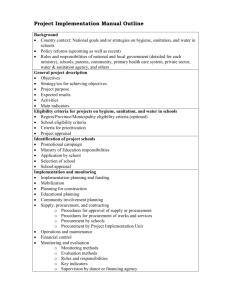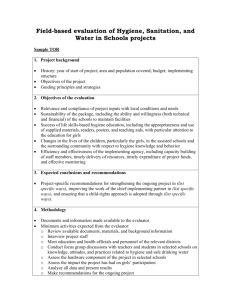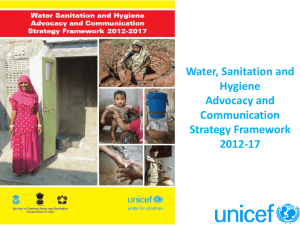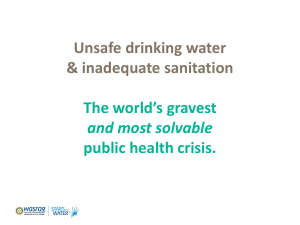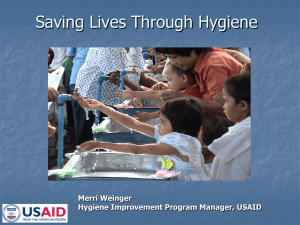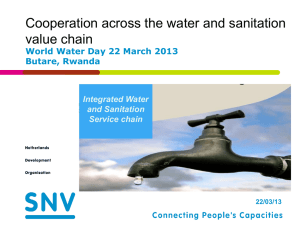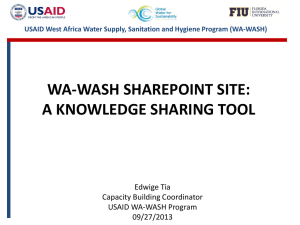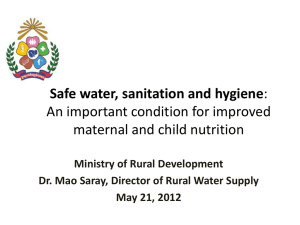Emergency Water SupplySanitationHygiene
advertisement
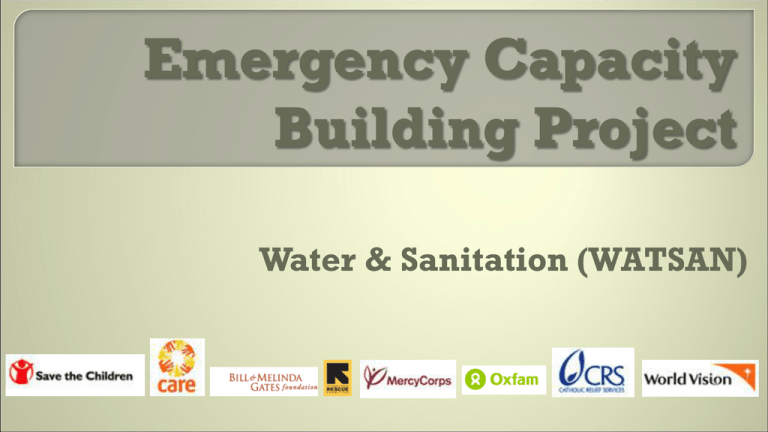
Emergency Capacity Building Project Water & Sanitation (WATSAN) Emergency Water Supply, Sanitation & Hygiene Promotion Establish conditions that allow people to live with good health, dignity, privacy, comfort and security. To mitigate health risks associated with waterborne and sanitation related diseases Promote the active participation of women and men from the affected community in the response To bring about behavioral changes among effected communities in favor of safe hygiene practices Water Supply - is the means by which people are provided with water for domestic use. This is water used for drinking, cooking, washing, and other domestic activities Sanitation - all aspects of excreta disposal, including sanitary structures (e.g. latrines); material needed for the proper operation and use of the structures (e.g. water, soap) Hygiene Promotion - mix between the beneficiary's knowledge, practice and resources and agency's knowledge and resources, that enables risky hygiene behaviours to be avoided. Susceptibility People affected by disasters are generally much more susceptible to illness and death from disease, due to fatigue, malnourishment, stress and removal of traditional social structures and coping mechanisms Change in lifestyle There is a fundamental change in the way people live – overcrowding, lack of services, and forced adoption of unfamiliar practices increase the likelihood of disease transmission Watsan & HP activities can be reflected in the Code of conduct in the following areas: The right to receive humanitarian assistance and to offer it ( humanitarian imperative) Response is not imposed upon beneficiaries- full community participation Working to reduce future vulnerabilities as well as meeting basic needs Accountability of humanitarian agencies Disaster victims are treated with Dignity What are minimum standards? Sphere definition: minimum levels to be attained in the provision of water, Sanitation & Hygiene promotion. Mainly qualitative in nature. Water supply - Access+ Quantity, Quality, facilities on water use Sanitation –Access+number of toilets, design, construction & use of toilets, Vector control affected community having the knowledge and means to protect themselves form disease vectors; physical, environmental & chemical protection measures What are indicators? Sphere definition of indicators: Indicators are signals that show whether the standard/s have been met. Provide a way of measuring and communicating the result of a response. Can be qualitative or quantitative. E.g. 15 l/p/d, 20 people/latrine, population at risk understand mode of transmission and possible methods of prevention Priorities ( first phase intervention): Water quantity and quality Clean environment (safe excreta & solid waste disposal) Hygiene promotion Appropriate potable water systems Consider quality and treatment needs Organize awareness raising activities Bang Bang Identify most important Watsan health risks Safe excreta disposal (impact on diarrhea reduction 36%) Drinking safe water (impact on diarrhea reduction 15-20%) lack of water Hand washing (impact on diarrhea reduction 33%) Mortality and Morbidity Diarrhea diseases Malaria Human Rights & Dignity Rights based approach to humanitarian response Defined as the mix between the population’s knowledge, practice and resources and agencies knowledge and resources, which together enable risky hygiene behaviours to be avoided. Its three key factors are a) a mutual sharing of information and knowledge b) the mobilisation of communities and c) the provision of essential materials and facilities. Informing Educating Consulting Communicating Enabling Mobilising Advocating In an emergency we target the three highest risk practices first Often it is the case that use of latrines, handwashing and disposal of child faeces are the highest risk practices to target Conduct an Assessment by going to your mentors and interviewing them about their habits, living conditions and environment. Using the SPHERE standards • 4 key indicators • List 4 priority questions. Make an action plan for responding to the immediate needs using these indicators and priorities. The following is a short Scenario to consider About 2,000 displaced are sheltering at a mission. Only one borehole but it is broken. There is no nearby surface water. You have a small (500 litre) trailer to draw water for use from a large borehole 20km away. A local contractor can provide one 5,000 litre tanker and one 10,000 litre tanker. These could make up to 3 trips a day each. What are the possible solutions? What should you do and why? At least 15 liters of water per person per day There is at least 1 water point per 250 people A maximum of 15 minutes waiting time The maximum distance is 500 meters The need is 30,000 litres per day (2,000 people at 15 litres per day each) The 10,000 litre tanker could supply this with 3 trips a day Hiring both tankers to make two trips a day each gives you reserve capacity if one breaks down You could also have 3 trips a day at the start to fill whatever storage the mission has You need to follow up on the borehole repair If the fault was a result of poor maintenance you could think about training You could consider drilling a second borehole at the site to avoid this problem in future If more refugees are expected to arrive, plans must allow for a substantial spare capacity over the initially assessed needs.
